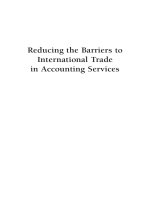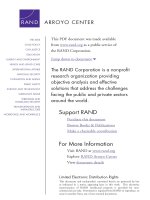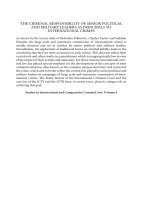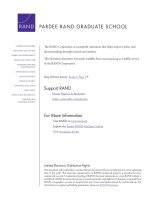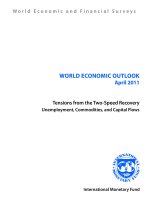Modeling Barriers to International Capital Flows: A Multicountry Framework
Bạn đang xem bản rút gọn của tài liệu. Xem và tải ngay bản đầy đủ của tài liệu tại đây (64.07 KB, 16 trang )
338
Modeling Barriers to International Capital Flows: A Multicountry Framework
A. Seddik Meziani
Montclair State University, USA
Abstract
To explain the bias in favor of domestic securities known as the “international diversification puzzle,” the
literature has considered many possible irritants of capital movements across national boundaries but the
results remain inconclusive. This paper demonstrates that this complex multivariate problem can be
addressed within an analytic hierarchy process (AHP)-driven expert system. The AHP can be modeled to
select an optimal investment portfolio (OIP), herein a multinational portfolio composed of national markets
where barriers to capital flows are least likely to adversely affect its return. Experts examined these barriers
in relation to six national markets and the euro zone. The U.K. turns out to be their market of choice closely
followed by Canada, and the Euro Zone. There is gain to be made from using the opinion of those with first-
hand understanding of foreign markets and knowledge-based expert systems such as the AHP are best suited
to capture that expertise.
Introduction
The underlying theoretical basis of diversification formalized in Markowitz Portfolio Theory and the Capital Asset
Pricing Model has been well documented in the finance literature. International diversification enables investors to
reduce the unsystematic risk of investing in one economy. Business cycles do not happen uniformly across
countries; when one country is experiencing rapid growth, another may be in a recession. By investing across
countries, investors should logically eliminate from their portfolios part of the cyclical fluctuations that would arise
from the domestic business cycle. Such investors will only be exposed to systematic risk related to the global
economy.
Since Markowitz’s seminal work (1952), many of the studies that have explored the merit of holding
international assets as a part of a strategically balanced portfolio confirm diversification as the most important
motivating factor in international investment. For example, in Worzala’s survey (1994) diversification is ranked as
very important by a substantial majority of respondents. In a survey of British investors, Baum (1995) also finds
diversification as the main motivator of international investment.
But in spite of the theoretical and matter-of-fact groundings of international diversification, many studies
have demonstrated that investors nevertheless hold portfolios that consist nearly exclusively of domestic assets. This
violation of standard theories of portfolio choice is known as the “international diversification puzzle.” For example,
in 1991 French and Porteba report that U.S. investors hold about 94 percent of their financial assets in the form of
U.S. securities. For Japan, U.K., and Germany, the share of domestic assets in each case exceeds 85 percent. They
find an explanation to the apparent tendency of U.S. pension funds to overweight their own equity market in explicit
limits on cross-border investment known as the ‘prudent man’ rule. In Japan where insurance companies cannot hold
more than 30 percent of their assets in foreign securities this rule is also interpreted as limiting their degree of
international exposure. In France a foreign investor may not hold more than 20 percent of any firm without prior
approval from the Ministère de l’Economie et des Finances.
In 1995, Tesar and Werner showed that domestic assets continue to overwhelmingly dominate portfolios
despite the rapidly growing volume of international financial trade. They examined the foreign investment positions
of major industrial countries and found that international investment as a fraction of the total domestic market of
stocks and bonds equaled about 3 percent for the U.S., 4 percent for Canada, 10 percent for Germany, 11 percent for
339
Japan, and 32 percent for the United Kingdom. Excluding the U.K., calculations of a diversified portfolio would
have much higher fractions devoted to international assets.
So why do investors seem to have this bias in favor of securities of their home country? Standard models of
optimal portfolio choice cannot rationalize this pattern of asset holdings, even in the presence of unhedged foreign
exchange risk. Of the several possible reasons, Worzala (1994) finds that transaction costs in less liquid markets and
particular taxation regimes such as a dividend withholding tax on payments to foreign shareholders could have
significant repercussion for investment performance. He considers them among the most significant irritants of
capital movements across national boundaries.
Barriers to capital movements can take many other forms such as foreign exchange and capital controls.
Exchange controls increase pure exchange rate risk while capital controls restricts capital flows across national
boundaries. Where formal capital controls on foreign investment exist, securities command abnormal risk premium.
Both effects are well documented in the literature (Errunza and Losq, 1985; Eun and Janakiramanan, 1986). Or
perhaps, evidence given by Gatti and Tverski in 1990 that households behave as though unfamiliar gambles are
riskier than familiar gambles even when they assign identical probability distributions to the two gambles should be
given serious thought in future investment portfolio research.
Obviously many factors can constraint the flow of capital movements across national boundaries. Various
methodologies have been used to explain investors’ bias in favor of domestic securities but the results remain clearly
inconclusive. This study advocates a different approach to this multivariate problem. It suggests that this problem
can also be addressed within an analytic hierarchy process-knowledge-based expert system.
First, the finance literature is used to identify the most significant barriers to international capital flows.
These barriers are then submitted to the review of a sample of international investment experts operating in the New
York metropolitan area. Using their market experience, they identify the most formidable of these barriers by
comparing them to each other. They also compare them in relation to a sample of countries they were provided with.
This identification and selection process ultimately generates the optimal investment portfolio (OIP). This
diversified portfolio best represents a frictionless multinational portfolio. It is composed of national markets where
barriers to international capital flows are least likely to adversely affect its return. This process takes full advantage
of practitioners’ knowledge of these markets by providing them with a comprehensive model that integrates the
effect of all the interactive parameters.
The Analytic Hierarchy Process (AHP): A Knowledge-Based System Model
This research illustrates how the OIP can be formed based on the analytic hierarchy process (AHP), first developed
by Saaty (1980). The AHP is a simple decision analysis model appropriate when the decision maker wants to deal
with complex, unstructured, and multi-attribute problems in arriving at the overall best decision. Applications of the
AHP have been reported in numerous fields such as conflict resolution, project selection, budget allocation,
transportation, health care, and manufacturing, but it has yet to be applied to portfolio selection. The strength of the
AHP lies in its ability to mimic practitioners’ judgment about the importance that would be attached to different
influential factors and to structure a complex and multi-attribute system matrix. The AHP assumes the three basic
principles of logical analysis: constructing hierarchies, establishing priorities, and maintaining logical consistency.
Structuring The Hierarchy
The AHP initially breaks down a complex multi-criteria decision-making problem into a hierarchical structure. The
hierarchy pyramid is structured by enumerating the relevant elements that should enter into the decision outcome.
The elements are then grouped in levels.
The top level of the hierarchy, referred to as focus, consists of a single element or goal, which is the overall
objective. The elements that affect the decision are called attributes or criteria. They are included in the subsequent
levels, each of which may have several elements. Attributes are mutually exclusive and their priorities are
340
independent of the elements positioned below them in the hierarchy. The lowest level of the hierarchy is referred to
as alternatives, which are decision options (see Fig. 1) (Saaty, 1980).
Setting Priorities
Once the problem has been decomposed and the hierarchy constructed, the prioritisation procedure starts in order to
determine the relative importance of the elements on the next higher level. The pair-wise judgment starts from the
second level (first level of attributes) and finishes in the lowest level alternatives. The AHP uses pairwise
comparisons to establish priority weights for all elements in the hierarchy. Pairwise comparisons are repeated until
all combinations of elements have been exhausted. The level comparisons result in a “priority vector,” which
indicates the relative importance of the elements with respect to each criterion.
The decision maker must express preference between each pair of elements. Each pairwise comparison is
scored as: equally important (1), moderately more important (3), strongly more important (5), very strongly more
important (7), and extremely more important (9) (Saaty, 1980; 1982). An even preferential number scoring system
can also be used to represent comparisons among a pair of attributes. This method of ranking enables the decision
maker to incorporate his/her experience and knowledge in an intuitive and natural manner.
Maintaining Logical Consistency
After forming the preference matrices, the mathematical process commences in order to normalize and find the
priority weights for each matrix. The AHP process then determines the consistent nature of the pairwise
comparisons (i.e. consistency ratio (CR)) for all matrices. If the CR value is larger than 0.10 (which is the acceptable
upper limit for CR (Saaty, 1982)), it implies that there is a 10 per cent chance that the elements are not compared
well. In this case the decision maker must review the comparisons again.
The mathematical process then starts to integrate the assigned weights in order to develop an overall
evaluation process (i.e. the mathematical process to determine the CR values and the corresponding weights for each
alternative). Although the mathematical process of the AHP is tedious, the use of expert system makes it simple and
accurate to apply (Turban, 1993).
Level I: Overall Focus
Objective
Level II: Attribute 1 Attribute 2
Sub-attribute Sub-attribute Sub-attribute Sub-attribute Sub-attribute Sub-attribute
1 2 3 1 2 3
Alternative Alternative Alternative
1 2 3
Fig. 1: A GRAPHICAL REPRESENTATION OF THE MECHANICS OF THE AHP
Level III:
Level IV:
341
Application Of The AHP Model
The hierarchy in this application contains four levels (see Fig. 2). The first level of the hierarchy identifies the
objective: selection of the OIP. The second and third levels are the intermediate levels, which include the criteria
and subcriteria used to achieve the overall objective. These are the macro (criteria) and micro (subcriteria) barriers
that determine the choice of the OIP. The fourth and final level of the hierarchy lists the particular national markets
from which this portfolio will be constructed. The macro and micro barriers to international capital flows are defined
in Table 1.
Pairwise comparisons are used to establish priority weights for all the elements of the hierarchy. First, the
decision maker provi des judgments about the relative importance of each macro and micro barriers of levels two and
three in terms of its effect on the overall objective. Next, a preference is specified for each national market (level
four) relative to each barrier. Given the information on the relative importance of the barriers and national market
preferences with regard to each barrier, a mathematical process is used to synthesize the information and provide
priority measures indicating the ranking of all the national markets.
Table 1: DEFINITION OF MACRO AND MICRO BARRIERS TO INTERNATIONAL INVESTMENT
? Discriminatory Taxation: In some overseas markets, U.S. investors are more heavily taxed than domestic
investors.
? Exchange Risk: U.S. investors in overseas markets are subject to the risk of dollar appreciation, which
diminishes their total return when profits are repatriated.
? Legal Restrictions: U.S. investors face a complex web of regulations and rulings overseas, including:
o Foreign Ownership: Limitation of the percentage of foreign ownership of financial assets or
restriction of ownership to specific areas.
o Market Regulations: Foreign ownership flowing into or out of overseas markets might be
restricted through the imposition of capital controls.
? Liquidity Risk: In a shallow overseas market with insufficient demand, attempts to liquidate assets on a
large scale reduce the market value of the assets.
? Political Risks: Funds invested internationally fall under the jurisdiction of the host country, subjecting
international investments to rules established by local governments no matter how arbitrary or unfair such
regulations may appear. The most common types of political risks are:
o Expropriation of Assets: The government of the country where funds are invested confiscates the
capital investment.
o Repatriation of profits: U.S. investors are unable to convert earnings into dollars for the
repatriation of profit because of the host government’s rigid currency rules.
? Psychological Barriers: Distance from overseas markets and perceived differences in work habits and
standards may cause investors to hesitate in investing in foreign markets. This reluctance can be triggered
by the following:
o Language Barriers: U.S. investors can find it particularly difficult to conduct business in a
national market that uses a language with which they are unfamiliar.
o Source of information: Availability and dependability of information on individual companies
and industries may vary greatly from one national market to another. This set of data, if available,
may be hard to translate into familiar standards for comparison purposes. For example, differences
in accounting measurement and auditing practices between the United States and other countries
may make the financial statements from a firm located in a foreign market harder to interpret.
? Transaction costs: These are the costs incurred in placing the order and securing the certificates. Because
of the international dimension of the investment, these costs can be higher than domestic costs. Major
transaction costs are:
342
o Custodial fees: These fees cover international custodial services such as automated trade
notification, cash management services involving different currencies, and a network of sub
custodians in different countries.
o Management Fees: These are fees charged by international money managers. They might be
higher than those charged by domestic management because they reflect higher costs in terms of
international database subscription, research, communication costs, and so on.
Bold nodes represent macro barriers to international investment whereas clear nodes represent micro barriers.
The basis of this procedure is the completion of an “n x n” matrix where the entries (a
ij
) set forth the
answers to the series of questions included in the survey. For example, “Which national market (a
i
or a
j
) is more
advantageous for the U.S. global investor with respect to foreign exchange risk?” Using the comparison scale, the
answer to this pairwise comparison is entered into the “n x n matrix.” If the entry “9” is shown at the a
12
position
(e.g., Euro Zone vs. Australia), this means that national market a
1
(Euro Zone) is “extremely favored” over national
market a
2
(Australia) with respect to “foreign exchange risk.”
One result of a pairwise comparison of elements within the matrix structure is that a diagonal that runs
from the upper left corner of the “n x n” matrix to its lower right corner is composed entirely of cells with the value
“1.” This depicts the comparison between a national market and itself. Once the upper triangular portion values
above the “1 diagonal” are known, the lower triangular portion values can be determined because the transpose
values are reciprocals (Saaty, 1982). Subsequently, in our example above, 1/9 is entered at the symmetric position
a
21
. Once all the entries of the matrix are available, one can easily solve for the priority weights for all elements in
the hierarchy.
Sample Design
The size of the sample is limited to seven markets to minimize inconsistencies in respondent judgments. A larger
sample would generate an excessive number of pairwise judgments, which would heavily tax the capacity of the
respondents to be consistent throughout the survey (Miller, 1956). Also, as the collaboration of U.S. global
investment experts is critical to the completion of this study, a larger sample would mean a longer survey, which
could limit the number of responses, thereby weakening the results of the analysis. Choice of the countries used in
this analysis assumes that a low correlation coefficient between the U.S. market and other national markets is a key
capital flow driver. It is generally accepted that if markets tend to experience somewhat identical cycles,
diversification across national markets will be less effective.
Note that, in the sample, the Euro Zone is the area in which the euro is the single currency for its twelve
members.
1
Due to a lack of common statistics, the inclusion of the Euro Zone in the sample is justified by showing
the correlations of Germany and France with the U.S in Table 2. This choice should be self-explanatory. In addition
to being considered the two “economic engines” of Europe, their macroeconomic aggregates are widely viewed as
having initially set the benchmarks for inclusion in the Euro Zone.
Table 2 reports the correlations coefficients among the monthly returns of nine major stock markets in
1987-2000. Of the eight correlations reported between the United States and the eight other markets (bottom row),
the highest is the coefficient between Canada and the United States (0.77). This comes as no surprise since Canada,
being a neighboring country and the largest U.S. trading partner, has strong business linkages with the United States.
The next highest correlation is found between the U.S. and the U.K. markets (0.67). Given the strong linguistic and
economic ties between the two countries, the high correlation is also not surprising. On the other hand, the lowest
correlation is found between the U.S. and the Japanese markets (0.26). This is to be expected considering that the
1990s saw the United States in a long and strong business cycle expansion. But the decade brought only severe
recession in Japan.
343
The correlation coefficient matrix as a whole conveys that capital markets are becoming increasingly
integrated. However, although their convergence has gradually decreased some of the benefits of international
portfolio diversification, the correlation coefficient between markets are still far from 1.0, indicating that there are
still factors acting against their total integration.
Data Collection
The AHP does not need a formal data set. It requires that experts use experience gained in the field to state
judgments on criteria and alternatives. In this case, qualitative judgments on the barriers to international capital
flows as defined in Table 1 are obtained from a 25-page questionnaire mailed during the fourth quarter of 1999 and
first quarter of 2000 to 40 randomly selected firms operating international investment divisions in the New York
metropolitan area. Bearing in mind that this study is based on the interview survey method conducted in an
international context, the response rate could be considered fairly high with 15 respondents completing the survey.
2
The respondents are high enough in their institutions’ management hierarchy to have decision
responsibility. Their experience making international investment decisions ranges from 3 to 10 years with an
average of 4 years and 9 months. The names of the institutions that responded and accepted to be subsequently
interviewed are listed in Table 3. Note that this list excludes five participants who did not answer all the questions in
the survey because of their stated lack of expertise in some of the specific national markets included in the sample.
All of the respondents insisted on having their names and remarks kept confidential. Two respondents also insisted
on having the names of their employers undisclosed. In effect, the survey’s findings reflect the answers of 15
representatives although Table 3 lists only 13.
TABLE 2: CORRELATION COEFFICIENTS AMONG MONTHLY RETURNS OF MAJOR STOCK MARKETS, 1987-1998
(All returns are converted to U.S. dollars)
Correlation Coefficients
Stock Market AU CA FR GE HK JA SI UK
Australia (AU)
Canada (CA) 0.65
France (FR) 0.43 0.46
Germany (GE) 0.33 0.35 0.68
Hong Kong (HK) 0.62 0.65 0.42 0.38
Japan (JA) 0.25 0.29 0.42 0.25 0.19
Singapore (SI) 0.68 0.63 0.47 0.45 0.78 0.37
United Kingdom (UK) 0.6 0.59 0.59 0.52 0.58 0.45 0.66
United States (US) 0.56 0.77 0.55 0.42 0.61 0.26 0.66 0.67
Source: Morgan Stanley's Capital International Perspectives (1999).

